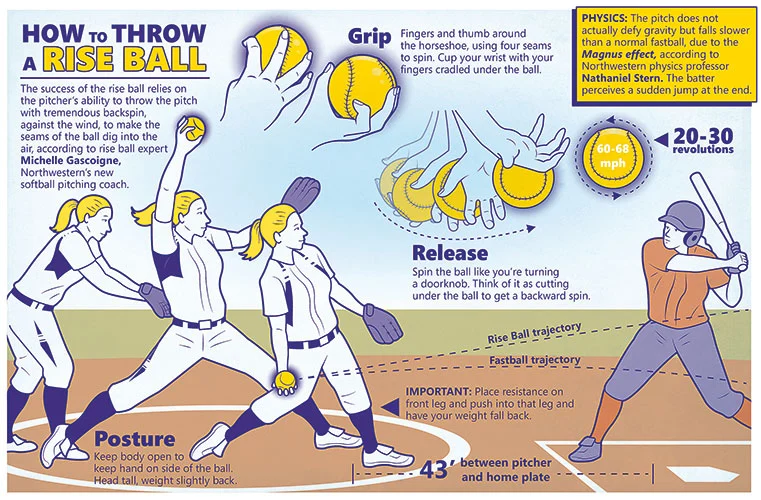The rise ball is often regarded as among the most challenging pitches to perfect. This is the reason why many coaches prefer to spend so much time teaching this pitch for the last. With that in mind, it is essential to master the right technique for the rise ball. We will teach you how to throw a rise ball in softball in this post right now!
What is a Rise Ball in Softball?
A rise ball, used in fastpitch softball, is a pitch that is thrown with a backspin and an upward trajectory (6 o’clock to 12 o’clock) to deliver a rising movement. Just as its title indicates, a rise ball gives the hitter the perception that the ball is actually rising.
The rising ball is fast pitches. Players often deliver it at speeds similar to the pitcher’s fastball speed. At the collegiate level for women’s softball, players usually throw a rise ball between 60 and 70 mph. The most successful pitchers even can reach speeds of more than 70 mph.
Why Should You Throw a Rise Ball?
If you are able to throw a rise ball, you will most likely have a greater chance than any other pitch of getting the batter to strike out. Yet, if you are failing in imparting the ball rise, you’ll likely be handing the batter a quite simple shot.
In other words, the rising ball is a high-stakes pitch that carries a significant risk but, when used effectively, also carries a great payoff.

When decided to throw a rise ball, here’re what you should expect from the batter:
- The batter will run an unhittable pitch above the strike zone: A well-executed rise ball will start at the batter’s strike zone or slightly below and then rise above the strike zone. This can cause the batter to swing at the pitch, thinking it’s hittable, but then miss as it rises out of the strike zone.
- The batter will swing and miss under a high strike: If the batter does swing at the pitch, they may miss because the pitch has risen above their bat. This can lead to a swinging strikeout.
- Hit a catchable fly ball: If the batter makes contact with the rise ball, it’s likely that they will hit a fly ball. The upward movement of the ball can cause the batter to hit the ball high in the air, giving fielders a chance to catch it for an out.
How to Throw a Rise Ball in Softball
You can correctly execute the rise ball once you use your grip, stride, posture, release, and follow-through in the appropriate way.
So here is how to throw a rise ball with the correct use of the above factors.
The Grip
Your particular hand size and shape will have a big impact on your grip. You have two choices for grip:
The “C” or four-seam fastball grip
The “C” grip, in which your top 4 fingers and thumb form a C shape around the ball with the seams running horizontally as opposed to vertically. This grip form is popular among players.

Horseshoe Grip or Two-seam fastball grip
Place your second and third fingers’ pads on the ball’s narrows (where the seams are most closely spaced). You use your index finger to press against or dig into the side of the ball.
You want to feel a little bit more weight on the inside of your fingers while holding the ball across the 2 seams rather than total balance.
With your thumb up, you should be able to feel the ball more in your fingers without really grasping it tightly. You’ll be able to give the ball as much spin as possible by doing this.
The Hip
On release, your hips should open. You should also consider turning a doorknob, trying to get under the ball, and getting all four seams to move up and backspin.
Tossing a beautiful rise ball with a flawless backspin is really difficult. As a result, the ball will frequently be spinning somewhat at an angle.
The Posture
You should check whether you’re positioning properly or not before you release. Always keep in mind a significant factor in determining where the ball travels after being released depends on how you hold your head.

Besides, make sure you are holding your weight back as well. Having your weight back is necessary for a nice rise ball.
The ball won’t rise if you lean forward as you do when you drop. To get everything under the ball when you deliver on this pitch, lean back a little bit, pull your shoulders back, and focus on your spin.
To shift the weight back a little bit further when doing this, attempt to lift your foot up high and extend your glove a little more. You’ll have a higher chance of the ball traveling upward and into the sky, if you’re leaned back like this with your head towards the sky.
The Release
You should focus on turning your right hand towards third base if you are a right-handed pitcher. Being mindful of turning your left hand towards the first base is important if you pitch with your left hand.
Your hand should be immediately spun back upon release in all scenarios. Remember to spin a doorknob-like motion with your hands to throw a rising ball. As a result, the ball will then gain the necessary backspin to rise.
Follow-through
Finish by raising your throwing hand and pointing your index finger upwards when you throw a rising ball.
Go completely around and under the ball. Your belly button or chest will be where you end your follow-through.
Practice for a Perfect Rise Ball
Strengthen Your Pitching Arm
Strength is the minimum requirement for any pitching technique.
To enhance your throwing arm strength, workout these exercises:
- Push up
- Shoulder flies
- Tricep dips
- Bicep curls
- Overhead throws
- Medicine ball wall throws
Check out my definitive guide to improving your throwing arm strength with simple exercises.
Backspin Drill for Rise Balls
Start with the open position, with someone across from you waiting to catch the ball as well as a coach nearby, keeping a tight eye on your hand.
Grip the ball in the way described above. Then, simply throw a rise ball to the guy across from you, attempting to get as much backspin on it as possible.
At this point, fret not about throwing the ball so fast. You’re simply trying to master the backspin. Continue throwing the ball back and forth with the player across from you to practice your backspin.
Before doing any form tweaks, have your coach or somebody who is experienced with good rising ball technique review your hand. Throw the ball back and forth till you’re comfortable with your backspin form, making any necessary corrections.
FAQs
Does a rise ball really rise in softball?
No. Honestly, the rising ball does not rise. In theory, the Magnus effect doesn’t have sufficient force for the ball to defy gravity. It only permits the ball to drop far less than a player would predict.
Why is the rise ball hard to hit?
Most players find gripping the hands above the ball pretty challenging. When the ball is rising, most swing contact will result in a ball in the air rather than on the ground.
How to make a rise ball even harder to hit?
The rise ball itself is already a hard pitch for most batters. But if you want to level up your pitch, you can try to vary the speed of each pitch. In that way, your throws can be unpredictable to the hitter.
Conclusion
The rising ball, like any challenging pitching method, needs a lot of practice to master. Don’t give up the game in a hurry!
The more you exercise this pitch, the quicker you will master it. Once you’re ready to throw a rise ball, start by just using our technique after you’ve already received two strikes on the batter.
Norman Dang is a diehard softball fan with full of energy and enthusiasm. He has over ten years of experience in playing softball and coaching softball for kids. He shares his expertise on the SoftballTriple blog.

